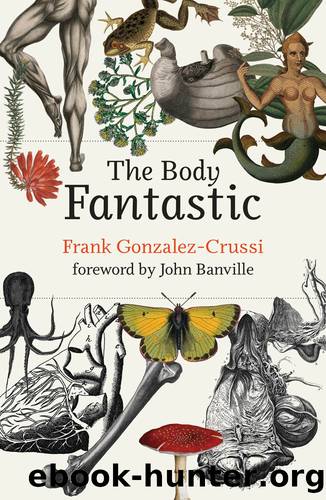The Body Fantastic by Frank Gonzalez-Crussi

Author:Frank Gonzalez-Crussi [Gonzalez-Crussi, Frank]
Language: eng
Format: epub
Tags: science, Life Sciences, Human Anatomy & Physiology, Literary Criticism, Fairy Tales; Folk Tales; Legends & Mythology, art, Subjects & Themes, Human Figure
ISBN: 9780262045889
Google: 1_Y3EAAAQBAJ
Publisher: MIT Press
Published: 2021-08-10T00:26:01.635551+00:00
The Peak of Hairâs Glory: Its Association with Magic and Beauty
This relentless growth, unfaltering in disease, unwearying through fatigue, hunger, or psychic distress, could not have failed to impress the reflective and titillate the imaginative. Hence the creation of fantastic stories about the hairâs proliferative potency. An often-quoted report in this context came in 1680 from Germany. Various authors attribute it to a chronicler named Wulferus, who, in his work Philosophical Collections, gave the account of a woman buried at Nuremberg, whose grave was opened forty-three years after her death.16 Her hair had continued to grow all these years, and so luxuriantly that it was found to cover the whole extent of her body. During the exhumation, as soon as the black-painted coffin appeared, it was noted that her hair had managed to grow out of it through the interstices it had encountered. When the cover was removed, it looked as if the body had retained its shape, but this was a deceptive appearance; for when the grave-digger tried to handle the head, everything crumbled. There was no skull or any other bone: all had turned to dust. All that remained in the grave-diggerâs hands was hair; solid, long, thick, and curled hair.17
So great was the vitality attributed to hair that many people believed it continued growing even in carcasses. More than one far-fetched account described men who were hanged, left suspended as a public example of the power of justice and a deterrent to potential criminals, and their hair continued to grow while the decomposing body was left exposed on the gallows.18 Another Kafkaesque story dates from the eighteenth century. It concerns a Frenchman, Professor Tamponette, eminent âman-midwifeâ and self-appointed naturalist, who possessed a private collection of natureâs curiosities. Included in it was the cadaver of one of his students, an exceptionally hirsute and thickly bearded young man, whom the professor embalmed, it was said, according to the method used by the ancient Egyptians. One day, the beard accidentally caught fire, and the originator of this accident, one of Tamponetteâs students, was desperate. To remedy the mishap, he thought of no better expedient than to take out his own razor blade and soap, and ipso facto shaved off the mummyâs beard entirely. The next dayâmiracle!âthe beard had grown back, and continued to grow so vigorously that it had to be shaved weekly, for years, to the unbounded admiration of the many visitors to Tamponetteâs collection.19 A note in an English encyclopedia included, with British circumspection not lacking irony, a note warning the readers that âsome moderns deny the authenticity of this and similar instances.â20
Today, forensic pathologists, coroners, physiologists, and other experts agree that claims of postmortem growth of hair and nails are false. During life, nails grow at a rate of 0.1mm/day, or 0.12 inches/month; and hair, about 0.35mm/day, or approximately 0.4 inches/month. As with all bodily structures, this growth depends on cellular activity. The cells that produce the material of which hair and nails are made require oxygen. In death, the blood circulation ceases, and so does the supply of oxygen to the cells.
Download
This site does not store any files on its server. We only index and link to content provided by other sites. Please contact the content providers to delete copyright contents if any and email us, we'll remove relevant links or contents immediately.
Kathy Andrews Collection by Kathy Andrews(11731)
The remains of the day by Kazuo Ishiguro(8827)
Paper Towns by Green John(5092)
Spare by Prince Harry The Duke of Sussex(5074)
Industrial Automation from Scratch: A hands-on guide to using sensors, actuators, PLCs, HMIs, and SCADA to automate industrial processes by Olushola Akande(4985)
The Body: A Guide for Occupants by Bill Bryson(4975)
Machine Learning at Scale with H2O by Gregory Keys | David Whiting(4185)
Be in a Treehouse by Pete Nelson(3951)
Never by Ken Follett(3794)
Harry Potter and the Goblet Of Fire by J.K. Rowling(3775)
Goodbye Paradise(3728)
Into Thin Air by Jon Krakauer(3313)
The Remains of the Day by Kazuo Ishiguro(3295)
The Cellar by Natasha Preston(3262)
The Genius of Japanese Carpentry by Azby Brown(3226)
Fairy Tale by Stephen King(3220)
120 Days of Sodom by Marquis de Sade(3184)
The Man Who Died Twice by Richard Osman(2997)
Drawing Shortcuts: Developing Quick Drawing Skills Using Today's Technology by Leggitt Jim(2996)
